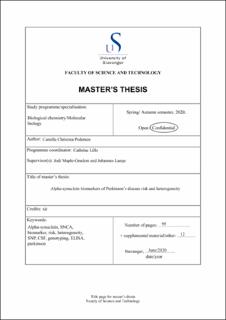| dc.contributor.advisor | Maple-Grødem, Jodi | |
| dc.contributor.advisor | Lange, Johannes | |
| dc.contributor.author | Pedersen, Camilla Christina | |
| dc.date.accessioned | 2020-09-29T08:19:01Z | |
| dc.date.available | 2020-09-29T08:19:01Z | |
| dc.date.issued | 2020-06 | |
| dc.identifier.uri | https://hdl.handle.net/11250/2680151 | |
| dc.description | Master's thesis in Biological chemistry | en_US |
| dc.description.abstract | Parkinson’s disease (PD) is the second most common neurodegenerative disease and is the world’s fastest growing neurological disorder. PD is a motor disease, but many patients experience a range of non-motor features, including cognitive impairment, depression, and sleep disorders. The course of the disease varies in each patient, which leads to uncertainty for both the patients and their families. Adequate diagnostic or prognostic strategies have yet to be established and there is no cure for PD.
PD biomarker research is important for the diagnosis and prognosis of the disease. Alpha-synuclein (α-syn) is a protein of great interest because it is the major component of Lewy bodies, the pathological hallmark of PD. Alpha-synuclein is encoded by the SNCA gene. Genetic variants of SNCA are associated with the risk of developing sporadic PD and are also an area of interest. However, findings have been inconclusive and further studies are required in order to draw conclusions regarding the use of α-syn and SNCA as protein and genetic biomarkers of PD.
The aim of our project was to study potential biomarkers that can identify individuals at high risk of developing PD and who are at high risk of a rapid disease course. In order to do so, two approaches were taken. The first was assessing single nucleotide polymorphisms (SNPs) in the SNCA region for associations with outcomes measuring PD progression. A systematic review of the literature was performed as part of the process of selecting candidate SNPs. Secondly, through the development of a novel ELISA, levels of phosphorylated α-syn on serine residue 129 in CSF were measured.
Further research on SNCA and pS129-α-syn as genetic and protein biomarkers is required in order to confirm our results and to further develop our ELISA. The broader implications of such work related to SNCA is that patients and their relatives could be better prepared for what to expect over their disease course. The development of our ELISA would provide a new assay for clinical use, in terms of being able to detect any alterations in the levels of pS129-α-syn in CSF after the administration of disease-modifying therapies. | en_US |
| dc.language.iso | eng | en_US |
| dc.publisher | University of Stavanger, Norway | en_US |
| dc.relation.ispartofseries | Masteroppgave/UIS-TN-IKBM/2020; | |
| dc.subject | Alpha-synuclein | en_US |
| dc.subject | SNCA | en_US |
| dc.subject | biomarker | en_US |
| dc.subject | risk | en_US |
| dc.subject | heterogeneity | en_US |
| dc.subject | SNP | en_US |
| dc.subject | CSF | en_US |
| dc.subject | genotyping | en_US |
| dc.subject | ELISA | en_US |
| dc.subject | biologisk kjemi | en_US |
| dc.subject | molekylær biologi | en_US |
| dc.subject | Parkinson | en_US |
| dc.title | Alpha-synuclein biomarkers of Parkinson's disease risk and heterogeneity | en_US |
| dc.type | Master thesis | en_US |
| dc.subject.nsi | VDP::Matematikk og Naturvitenskap: 400::Basale biofag: 470::Biokjemi: 476 | en_US |
